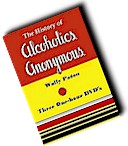|
From: Primer on Alcoholism,
by Marty Mann, 1950. Chapter 7, pages 105-107.
Belief in the possibility of recovery is growing apace today, but it had a slow and feeble beginning not so very long ago. In the years
following the first World War, word got around in certain circles (mostly wealthy) that a man named Courtenay Baylor in Boston was having some success in treating
alcoholics. He was not a doctor, nor a formally trained psychologist: he was what is called a lay therapist, and he worked in a clinic which was part of Emmanuel
Church, the seat of the Emmanuel Movement. The methods he used were both psychological and spiritual, combining to re-educate the alcoholic to a life without alcohol;
he described them fully in his book Remaking a Man, published in 1919. The Emmanuel clinic was for all kinds of nervous disorders, and did not specialize
in alcoholism, so that there was no great flood of recoveries to startle the world. Nevertheless a little hope was generated, and some alcoholics got well. A start had
been made.
Richard Peabody, also of Boston, was the next name to be associated with recoveries from alcoholism. Himself a product of Baylor's teaching, he
turned what he had learned wholly onto the problem of alcoholism, and specialized in the treatment of alcoholics. His book, The Common Sense of Drinking,
containing a description of his method, was published in 1931. A few of his successful cases entered the field as therapists, and by the mid-thirties still more
recoveries were giving the lie to the alleged hopeless of alcoholism."
Francis T. Chambers, Jr., of Philadelphia, was a follower of Peabody who in turn went a step further than his teacher. Under the guidance of Dr.
Edward A. Strecker, one of America's leading psychiatrists, Chambers took some formal training at the University of Pennsylvania Medical School, and entered the
Institute of Pennsylvania Hospital, as associate Therapist, specializing in alcoholism, but working in conjunction with a team of medically trained personnel.
Alcohol, One Man's Meat, published in 1938, is the book written jointly by Strecker and Chambers about their work. Out of their hands has flowed a small
but steady stream of recoveries ever since.
The methods of all the above have been generally lumped together under the heading of "lay therapy," a type of treatment, which has had
considerable success. One of its greatest contributions, however, was the proof it furnished that alcoholics could recover. This fact was a stimulus to other workers
and researchers, and helped provide a nucleus of favorable opinion to experimenters with other methods. Most important of all, word began to reach alcoholics that their
was not only a name for what ailed them, but hope that they might recover.
.
|
|

To learn more
about the events leading up to and following the foundation of A.
A., please watch and enjoy "The History of Alcoholics
Anonymous"
Ideal for Twelve-Step Groups, Treatment Centers,
Correctional Facilities, Aftercare Programs, as well as anyone
interested in the history of "The Greatest Spiritual Movement
of the Twentieth Century."
DVD I - The Miraculous Journey contains: AA's
Ancestors, AA's Four Founding Moments, How the Big Book was
Written, and Early Publicity.
DVD II - AA in the 1940's - Why it Worked contains:
AA's Meeting Formats, The Beginners' Meetings, Sponsorship, 4th
Step Inventory, 11th Step Prayer and Meditation, and 12th Step
Working with Others.
DVD III - AA Pioneer Stories and Unsung Heroes
contains: Joe-Look Magazine 1945; Unsung Heroes Anne Smith and
Sister Ignatia; Pioneer Stories of Rollie Hemsley, Fitz M, and
Jimmy B; The Springfield Seven; Judge John T; and more about the
co-founders Bill W (The Visionary) and Dr. Bob S. (Keep it
Simple).

|

